
UponArriving
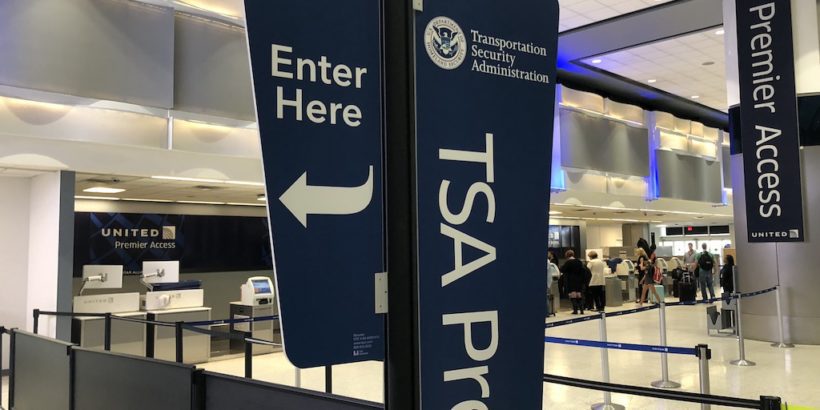

TSA Checklist (Tips & PDF) [2021]
If you’re getting ready to head to the airport make sure that you know exactly what to expect when it comes to TSA.
There are quite a few tips that I have to make your experience less stressful and a lot smoother so be sure to check out the tips below and the helpful PDF checklist at the bottom of the article.
Table of Contents
Before you head to the airport
Before you ever head to the airport, there are a few tips that you should consider.
Tip: Use the free app WalletFlo to help you travel the world for free by finding the best travel credit cards and promotions!
TSA Pre-Check
TSA Pre-Check is one of my favorite travel benefits that I’ve ever used and at this point I’ve probably used it a couple of hundred times.
It allows you to bypass the main security line which speeds up the airport security process a great deal in many cases.
In addition, you can often avoid the invasive full body scanners and you get the following benefits:
- Shoes can stay on
- Belt can stay on
- Light jackets can stay on
- Laptops allowed to stay in bag
- Liquids ( 3-1-1 Rule ) can stay in bag
The membership will cost you $85 for four years but you can often get it for free by choosing the right credit card.
You want to sign up at least a few weeks/months before your trip because you will have to attend an in-person appointment in order to register your biometrics.
Also, after you are approved you will need to add your Known Traveler Number (KTN) to your travel itineraries in order to receive the TSA Pre-Check benefits.
The best way to do this is to add your KTN to your frequent flyer profile. That will allow your KTN to be added to your itineraries automatically although sometimes you might have to verify that.
Packing your liquids
How to bring liquids through airport security is one of the most commonly asked TSA questions.
If you were planning on bringing liquids on a plane, you will be subject to the 3-1-1 rule. This rule means that your liquids must be contained within a container no larger than 3.4 fluid ounces (or 100 mL). You can fit as many containers as can comfortably fit within a quart size Ziploc bag.
The rule is straightforward but there are a few things that trip people up.
The rule goes by the size of the container and not how much fluid is inside the container.
For example, if you have a 5 ounce container with only 2 ounces of liquid, that container is still not allowed because the size of the container is larger than 3.4 ounces.
An exception to this is that TSA is currently allowing one oversized liquid hand sanitizer container, up to 12 ounces per passenger, in carry-on bags.
Another thing that trips people up is what is considered a liquid?
Some liquids are obvious like water but TSA also considers other substances to be liquids such as gels, creams, pastes, etc. You can read more about these here.
Another issue is with food.
Certain foods will be considered liquids while many other foods are allowed to be brought through airport security. To find out more about bringing food through airport security click here.
If you are planning on bringing alcohol there are also very special rules that you should be aware of . Contrary to what many people think, you actually are allowed to bring your own alcohol on a plane even in liquid bottles.
You just need to be aware of the alcohol content of the beverage and pay special attention to the restrictions for the different types of alcohol.
Pack the right toiletries
If you are taking your toiletries through airport security then you need to be extra careful that all of your toiletries are TSA compliant.
Some of the most commonly asked about toiletries include the following:
The biggest issue is typically that some toiletries violate the liquids rule so as long as you focus on complying with the liquids rule, you’ll usually be good for all of your toiletries.
Prohibited items
You always want to make sure that you are not bringing prohibited items through airport security. And that is not just because you will have to throw them out but some prohibited items can get you into some serious legal trouble.
Sharp items
One of the biggest mistakes some people make is bringing prohibited sharp items which include things like knives , certain types of scissors, and other items.
Some items are allowed like tweezers, small scissors, certain razors, etc. So it’s really important to understand the rules regarding sharp objects .
Explosives are obviously banned from getting through airport security but some people forget this when it comes to items like small fireworks or other explosive type devices such as flares.
If you’re traveling with a firearm then you need to keep these in your checked baggage and you also need to comply with the rules for transporting a firearm which include transporting it in a hard sided case that can be secured.
You can read more about traveling with a firearm here.
If you need to pack medication, the good news is that TSA is actually pretty lenient when it comes to allowing medication.
They allow exceptions to the liquids rule so that you can bring in liquid medications larger than 3.4 ounces and they don’t even require you to have a prescription (although state laws may require that).
Read more about the TSA medication guidelines here.
Coronavirus update
If you are traveling while pandemic conditions are occurring, you’ll want to make sure that you have the following items accounted for:
Most airlines will require you to wear a mask when flying and even when in the boarding area. Some airports might even require you to wear a mask when in the airport so be sure to have one handy.
Social distancing
While waiting in line, you will likely have to social distance so be sure to keep several feet between you and other travelers.
Read more about other TSA coronavirus measures here.
Once you’re at the airport
After you have knowledgeably packed your carry-on item, you are through with the hardest part of complying with TSA rules. But you still need to be mindful about a few things.
Arrive at the right terminal
You need to make sure you arrive at the right terminal so that you go through the proper security line.
In some cases, some airports will not allow you to go through security if you are attempting to go through a terminal that is not the terminal you are flying out of.
If you are trying to visit a particular lounge, such as a Centurion Lounge , you might want to enter a terminal that is not the terminal you will be flying out of.
TSA agents may allow you to do this but be prepared just in case you are not allowed to do this.
Also, you might be forced to re-enter through security when leaving the lounge terminal which is something I would only recommend to attempt if you are knowledgeable about the airport layout and waiting times.
Find your security line
Typically, when you arrive at the airport there will be up to four different options for you to go through security.
Standard security line
There is the standard security line which is open to all of the public. This will typically be the longest line and will sometimes be a very long and winding place that you will have to wait in.
Related: Does TSA Check For Arrest Warrants?
Tip: Sometimes a terminal may have multiple security lines such as a north and south line. So always look around to see if there is a shorter alternative if you are faced with a very long line.
If you have TSA Pre-Check then you need to look for the TSA Pre-Check line.
Sometimes the line can be a little bit hidden or pushed away to the side so look for the signs and if you don’t find one, simply ask an airport agent.
Just remember that some terminals do not have a TSA Pre-Check line and in other cases it may not be open during certain hours.
If you have CLEAR , look for the CLEAR line and enter that line based on whether or not you have TSA Pre-Check.
Airline priority lines
If you have elite status or if you are flying in a premium cabin such as business class, you may have access to the airline priority screening line. Even when I have this access I usually just choose to go through the TSA Pre-Check line.
Get your ID and boarding pass
In order to access a security line, you will likely need to show a government-issued ID and your boarding pass.
Make sure that you have an ID that is accepted (keep in mind the upcoming changes to the REAL ID Act) .
Keep in mind that due to the coronavirus:
- TSA will accept expired driver’s licenses or state-issued ID a year after expiration.
- DHS has extended the REAL ID enforcement deadline to October 1, 2021.
You can pull up your boarding pass with your phone using a mobile app for the airline you are flying on but you can also hold a printed boarding pass.
Try to have those already in your hand as you enter the line so that you do not hold it up and can smoothly get through. If you forgot your ID or realized you just lost it read up on what to do here .
Remove items for screening
When you arrive at the security screening checkpoint, you will need to do the following in many cases:
- Remove your shoes, jacket, belt, and hat
- Remove your electronics such as laptops and bulky cameras
- Remove your liquids bag
The main exception here is if you have TSA Pre-Check.
In that case, your clothing items can stay on and you can also keep your electronics and liquid bag within your carry-on bag.
Depending on the size of your carry-on bag, you may or may not have to place it in a bin.
Comply with additional screening (if needed)
In some cases, you might have to deal with additional screening.
If you have brought certain items such as powders or special items related to disabilities, your objects might need to be screened by a TSA agent. This is typically a pretty painless process that only last a few seconds to a couple of minutes.
In rare cases, you might be subject to SSSS which is a secondary screening process. You will know that you are subject to the screening because you will see the letters on your boarding pass.
In some cases, this can require a lot of time so this is why you do not want to arrive late because it could take you 20 minutes to get through this process depending on how the agents go about your screening process.
If you are consistently subjected to additional screening and don’t believe it is justified, considered applying for a redress number which can take you off certain lists that require more screening.
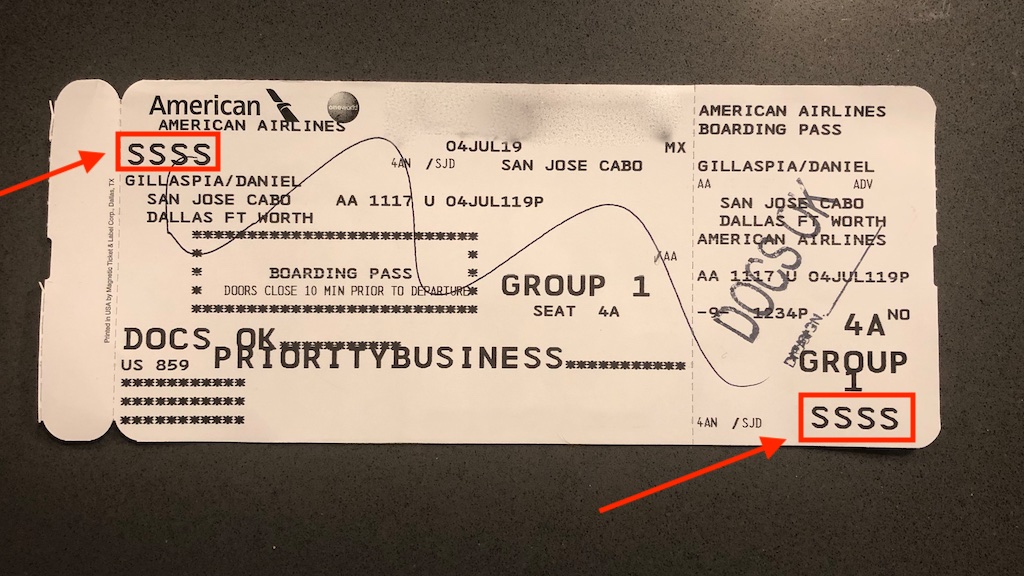
Collect all of your items
Your final step is to make sure that you don’t forget to collect all of your items after you go through airport security.
After you have dropped all of your items in your bins and walked through the metal detectors, and perhaps received additional screening, it can be a little bit disorienting and you might forget to collect your items.
The easiest way to not forget certain items is to make sure that you placed them inside your carry-on before you push them through the x-ray scanner.
I always make sure to stuff my wallet, ID, boarding pass, watch, keys, and any other every day item into one of the compartments in my backpack so that I always know where to find them.
This is especially true if you are traveling during a hectic time with a lot of people because that is typically when items are lost or stolen. If you do end up losing an item, here are tips for dealing with the TSA lost and found.
Getting through airport security can be a bit stressful and even intimidating for some people. But if you follow the steps on this checklist, you will know exactly what to expect and be prepared for just about any situation that could arise.
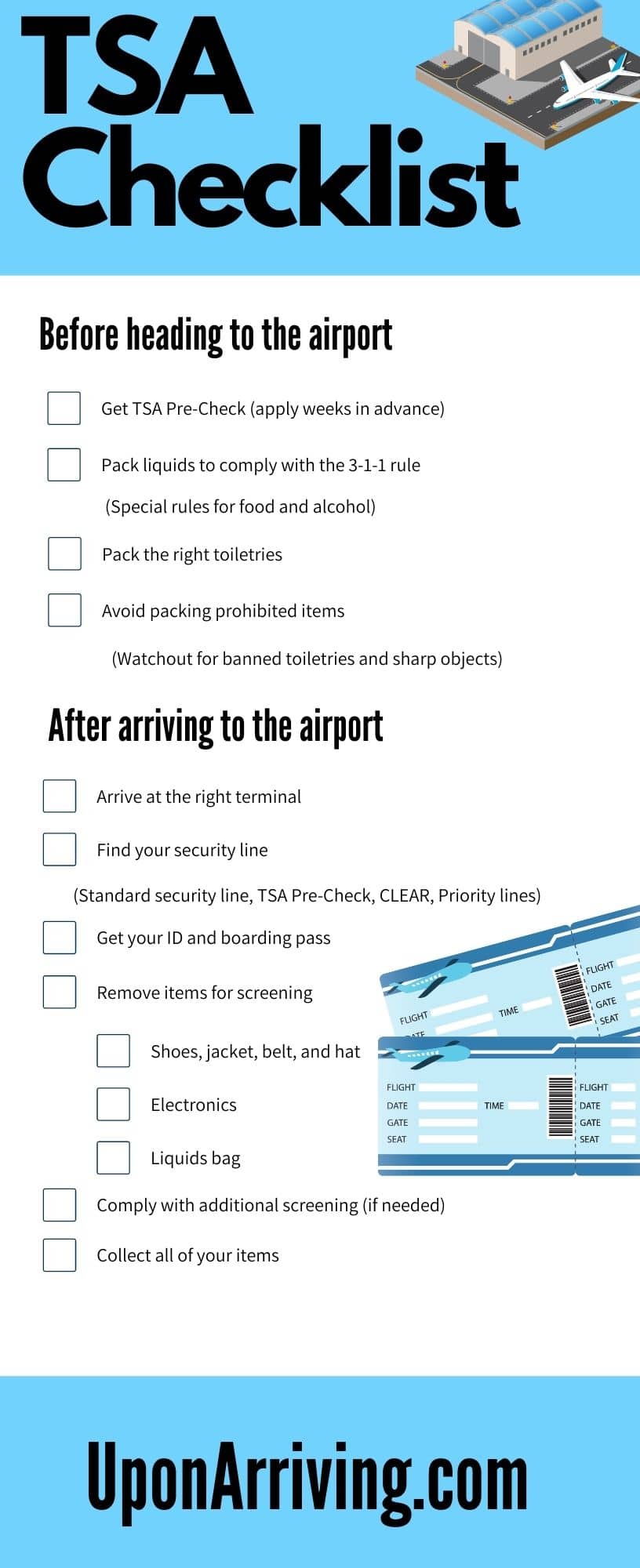
Daniel Gillaspia is the Founder of UponArriving.com and the credit card app, WalletFlo . He is a former attorney turned travel expert covering destinations along with TSA, airline, and hotel policies. Since 2014, his content has been featured in publications such as National Geographic, Smithsonian Magazine, and CNBC. Read my bio .
Privacy Overview

An official website of the United States government
Here’s how you know
Official websites use .gov A .gov website belongs to an official government organization in the United States.
Secure .gov websites use HTTPS A lock ( Lock A locked padlock ) or https:// means you’ve safely connected to the .gov website. Share sensitive information only on official, secure websites.
- For Travelers
Learn What I Can Bring on the Plane
Learn what you can bring on the plane by reviewing the Transportation Security Administration's (TSA) list of what you can bring on the plane, what you cannot bring on the plane, and TSA's Liquids 3-1-1 rule.
Please note that the final decision rests with the TSA officer on whether an item is allowed through the checkpoint.
For items not listed on the site, simply snap a picture or send a question to AskTSA on Facebook Messenger or Twitter . TSA looks forward to answering your questions, from 8 a.m. to 10 p.m. ET weekdays; 9 a.m. to 7 p.m. weekends/holidays.
What Can I Bring?
Know what you can pack in your carry-on and checked baggage before arriving at the airport.
What Should I Not Bring?
Know what you can pack before arriving at the airport by checking the prohibited items list.
Liquids 3-1-1 Rule
Read TSA’s liquid rule when bringing liquids in carry-on and checked luggage.
Other Travel Considerations
TSA.gov also has information to help those in specific situations, including:
- Disabilities and Medical Conditions
- Military Travel
- Traveling with Children
- Screening for Passengers 75 and Older
- Law Enforcement
- Cultural Considerations
- Transportation Security
- How Do I - For Travelers
- Transportation Security Administration (TSA)
An official website of the United States government Here's how you know
Official websites use .gov A .gov website belongs to an official government organization in the United States.
Secure .gov websites use HTTPS A lock ( Lock A locked padlock ) or https:// means you’ve safely connected to the .gov website. Share sensitive information only on official, secure websites.

Air Travel Tips
A collection of helpful tips and information to help you protect yourself while traveling.
- Disability Training Materials and Helpful Information
Frequently Asked Questions
- Other Consumer Tips
Air Travel Consumer Report
- Frequently Asked Questions on President Trump's Cuba Announcement
Other Information
Top questions.
- How can I get the best air fare ?
Is there anything I should keep in mind when packing?
What if my flight is delayed, if something went wrong, how can i file a complaint.
For additional information on these topics, click “ Other Consumer Tips ” above.
Before the flight
How can i get the best air fare, what factors should i take into account when choosing flights, what kinds of fees could i end up paying in addition to my fare, i need to cancel a reservation that i just made. can i get a refund, my child is flying alone. what preparations should i make.
- I want to take my pet with me on this trip. What does that entail?
At the airport
Where and when do i need to check in at the airport, what should i know about clearing security, what are my options if my flight is canceled, what are my rights if my flight is oversold, during the flight, what is the “tarmac delay rule”, what should i be alert to at my connecting airport, at your destination.
- Is there anything I should be alert to when I collect my checked bag?
What if my bag doesn’t show up?
After your trip.
- Be flexible in your travel plans.
The best deals may be available only on certain days of the week or particular hours of the day. The lowest fares are often blacked out during holiday periods, but you might be able to get a discount fare if you fly on the holiday itself.
- Plan as far ahead as you can.
Most airlines set aside only a limited number of seats on many desirable flights at the lower rates.
- Compare fares of different airlines.
Return to top
- A connection (change of planes) is sometimes cheaper than a nonstop, but it involves the risk of a misconnection if your first flight is delayed. If you have a connection, make sure your itinerary allows enough connecting time. Flights early in the day are less susceptible to delays.
- If you have a choice of nearby airports, your fare could depend on which airport you use.
Also, if the city where you live or the city where you are going is an airline “hub,” fares may be higher than for flights to or from other nearby cities because of reduced competition. You might save money by leaving from another nearby city.
- Most airlines now charge for checked bags.
- Some airlines charge a fee for ticketing depending on whether you purchase your ticket on the web, by phone, or at the airport.
- Most airlines charge extra for preferred seats.
If you want an advance seat assignment next to your traveling companion or family and the only available adjacent seats include a preferred seat, you might have to pay a fee.
- Many airlines offer early boarding for a fee.
- Except on longer international flights, you will usually pay for any in-flight meals or snacks, if offered, as well as for any available internet service, video entertainment and audio headsets.
- Most air fares require payment when you make the reservation, and most discount fares are non-refundable.
- DOT requires airlines to either hold a reservation for 24 hours without payment or refund a paid ticket — even a non-refundable one — if you cancel within 24 hours of purchase and you purchased your ticket more than 7 days before your flight.
Airlines are free to choose between holding a reservation without payment in these circumstances or refunding after payment; they don’t have to offer both options.
- Valuables (e.g., cash, jewelry, expensive electronics).
- Critical items (e.g., medicine, keys, passport, tour vouchers, business papers).
- Irreplaceable items (e.g., heirlooms, original photos).
- Fragile items. Consider shipping them in advance. If they must be checked, wrap them carefully in padding.
- Perishables
Many airlines limit their liability for loss or damage of these items on domestic trips. Try to carry them on your person or in a carry-on bag.
- Put items that you will need during the first 24 hours in a carry-on bag. Although most checked bags arrive on time, some may be delayed for a day or two.
- When purchasing a suitcase lock, remember that security inspectors may need to open your checked bags out of your presence.
If you wish to lock your bags, see www.tsa.gov for information on locks that security personnel can open and re-lock. If you use an unapproved lock and your bag is selected for inspection, security staff will break the lock if necessary.
- Put a tag on the outside of your baggage with your name, address, and phone numbers.
Most airlines provide free "privacy tags" which conceal this information from passersby. Put the same information inside each bag, and add an address and telephone number where you can be reached during your trip.
- Contact the airline well in advance.
- Most airlines offer “unaccompanied minor” service. Depending on your child’s age, this service may be mandatory.
- Children below a certain age (usually 5 years old) might not be allowed to travel alone.
- Older kids might be limited to nonstop or “through” flights depending on their age.
- Children above a certain age may not be eligible for unaccompanied-minor service.
- Airlines generally charge a substantial fee for unaccompanied-minor service.
- Read When Kids Fly Alone .
I want to take my pet with me on my trip. What does that entail?
- Most U.S. airlines accept pets.
Some airlines allow you to choose between bringing your pet on your flight as checked or carry-on baggage or shipping it as air cargo.
- Check with your airline to learn about restrictions on carrying pets.
Most airlines will not carry pets as checked baggage during the summer and winter although you might be able to ship your pet as air freight at those times. Airlines also embargo animals on very hot and cold days, so always have a backup plan for your pet. Many airlines will not transport snub-nosed and pug-nosed dogs and cats.
- You will need to supply an approved kennel.
The kennel for a carry-on pet must fit under the seat, and your airline will probably require that the animal remain in the kennel during the flight and in the airport. Your pet might count as one of your allowed pieces of baggage, and there may be an additional fee for the pet as well.
- Check with your airline to learn about all requirements for pets.
You may have to supply a health certificate from a veterinarian, and certain destinations may require a quarantine period upon arrival.
- For additional information, see Traveling with Animals .
- Check-in deadlines can vary by airline and airport.
You can find the check-in deadlines for your flights on the airline’s website and perhaps on your e-ticket confirmation.
- In most cases, you must be at the gate no later than 10 to 15 minutes before scheduled departure time for domestic flights. For international flights this deadline may be 45 minutes or longer.
- Allow time to check a bag and pass through security.
- Airlines may impose an earlier deadline for obtaining a boarding pass and seat assignment.
The most common such deadline is 30 minutes before scheduled departure for domestic flights and one hour for international flights.
- Allow more time than you think you will need to clear security.
- Passengers who look like they are 18 or over should bring a government-issued photo ID.
- Cabin luggage is generally limited to one carry-on bag plus one personal item (briefcase, purse, etc.).
Size and weight of allowable carry-on bags can vary by airline. This information must be included in your confirmation/itinerary.
- Don’t bring sharp items on your person or in your carry-on bag.
- TSA has a “3-1-1” rule for liquids, aerosols and gels in carry-on baggage.
Those substances must be in containers that are no more than 3.4 oz. in volume (100 ml), with all such containers in one clear quart -size plastic bag, and one such bag per passenger.
- For details see TSA’s Traveler Information site.
- Try to find out the projected length of the delay so that you can evaluate your options.
Airlines are required to regularly update the public on the status of delays of 30 minutes or more. But keep in mind that it is sometimes difficult for airlines to estimate the total duration of a delay during its early stages. Weather that had been forecast to improve can instead deteriorate, or a mechanical problem can turn out to be more complex than initially evaluated.
- If the problem is with local weather, all flights will probably be late and there is not much you or the airline can do to speed up your departure.
- If there is a mechanical problem with the aircraft for your particular flight, or if the crew is delayed on an incoming flight, you might be better off trying to arrange another flight.
It is sometimes easier to make such arrangements by phone than at the airline counter. Check to see whether you have to pay a penalty or higher fare for changing your reservations. Changing flights and airlines becomes more difficult and time consuming if you have checked bags.
- If you find a flight on another airline, ask the first airline to “endorse” your ticket to the new carrier, which could save you a fare increase. However, there is no rule requiring an airline to do this.
- Each airline has its own policies about what it will do for delayed passengers waiting in the airport terminal.
There are no Federal requirements regarding these amenities or services. If you are delayed, ask the airline staff if they will pay for meals or phone calls. Some airlines may not offer amenities if bad weather or something else beyond the airline’s control causes the delay.
- If your flight is canceled, most airlines will rebook you on their next flight to your destination on which space is available, at no additional charge.
If this will involve a significant delay find out if another carrier has seats and ask the first airline to endorse your ticket to that carrier, but be aware that there are no Federal requirements for the airline to do so. Finding extra seats may be difficult, however, especially over holidays and other peak travel times.
- If your flight is canceled or diverted or experiences a lengthy delay and you choose to cancel your trip as a result, you are entitled to a refund for the unused transportation — even for non-refundable tickets — and for any bag fee that you paid.
- If the airline offers travel vouchers to volunteers who are willing to give up their seat, every volunteer must be told about any material restrictions on the use of the vouchers before the prospective volunteer gives up his or her seat.
Such restrictions can include administrative fees, advance-ticketing requirements, capacity restrictions, blackout dates, or other provisions.
- If you are involuntarily denied boarding in an oversale situation, the airline must give you a detailed written notice explaining your rights, and you are usually entitled to substantial compensation in the form of a check.
The airline is free to offer travel vouchers as an option to passengers who are involuntarily denied boarding, but material restrictions must be disclosed in the manner described above.
- For further information, see the “Overbooking” chapter of Fly Rights .
- DOT rules state that at a U.S. airport, an airline may not keep passengers aboard an aircraft for more than three hours (four hours for international flights) without an opportunity to deplane.
This rule applies to departures and arrivals, and to U.S. and foreign airlines that operate at least one aircraft with 30 or more seats.
- Food and water must be offered at the two-hour point during such a delay.
- Airlines must provide operational lavatories, and medical care if needed.
- Certain exceptions for safety, security and air traffic control may apply.
- When you deplane from your first flight, check the monitor or schedule board at the connecting airport to make sure the gate assignment for your next flight hasn’t changed.
- Get to your gate before the gate-arrival deadline. Even if you have a boarding pass and seat assignment, late arrival at your gate opens the possibility of losing your seat.
When I collect my checked bag, is there anything I should be alert to?
- Check your bag tag number or name tag.
Many bags look alike; don’t claim your bag solely on appearance.
- If your bag arrives open, unlocked or visibly damaged, check immediately to see if any of the contents are missing or damaged.
- Report any problems to your airline before leaving the airport.
Insist that the airline create a report record and give you its number even if they say the bag will be in on the next flight. Get the agent's name and an appropriate telephone number for following up. This number is different from the reservations number.
- Open your suitcase immediately when you get to where you are staying and check for damaged items and evidence of pilferage.
Report any damage to contents or pilferage immediately by telephone. Make a note of the date and time of the call, and the name and telephone number of the person you spoke with. Follow up immediately with a certified letter or return-receipt email.
- The airline will take a report as described above and will begin tracing the bag. The vast majority of delayed bags turn up within a few days, often on the next flight.
- You are entitled to reasonable reimbursement for expenses you incur while waiting for the delayed bag, such as the purchase of toiletries and a change of underwear.
- At a certain point (as early as a week or two) the airline will declare a bag lost and will provide claim forms for you to fill out and return.
Airlines don't automatically pay the full amount of every claim they receive. Like insurance companies, airlines consider the depreciated value of your possessions, not their original price or the replacement costs.
- If you're tempted to exaggerate your claim, don't. Airlines may completely deny claims they can show are inflated or fraudulent.
- Generally, it takes an airline anywhere from four weeks to three months to pay passengers for their lost luggage.
- When airlines tender a settlement, they may offer you the option of free tickets on future flights in a higher amount than the cash payment. Ask about all restrictions on these tickets, such as "blackout" periods.
- Your first step is contacting the airline.
U.S. and foreign airlines are required to make available the mailing address and email or web address where complaints can be registered with the airline. This information must appear on the airline’s website, on all e-ticket confirmations, and, upon request, at each of the airline’s ticket counters and boarding gates. Airlines are required to substantively respond to written consumer complaints within 60 days.
- If you are not satisfied with an airline’s response you may file a complaint with DOT .
Other Consumer Tips
- Fly Rights A comprehensive collection of information for air travelers.
- Plane Talk Fact sheets and links on topics like flight delays, baggage and more.
- Tell it to the Judge Taking an airline to small claims court.
- When Kids Fly Alone ‘Unaccompanied Minors’ on airline flights.
- New Horizons: Information for the Air Traveler with a Disability
- Air Travelers With Developmental Disabilities
- Airline Consumer Contacts
- Common Terms in Air Travel
- Traveling With a Musical Instrument
- Passport Validity Period for Travel to Europe
Statistics on flight delays, consumer complaints and other matters at Air Travel Consumer Report
Most Viewed Reports
- Air Travel Consumer Report issued April 2018
- Air Travel Consumer Report issued March 2018
- Air Travel Consumer Report issued February 2018
- 2018 Air Travel Consumer Reports
- 2017 Air Travel Consumer Reports
- 2016 Air Travel Consumer Reports
- Air Travel Consumer Report Archive
- Airlines Policies on the Serving of Nuts
- Suggested Guidelines for Accessible Lavatories in Twin-Aisle Aircraft
- Air Travelers With Disabilities: Technical Assistance Manual for Airline Employees, Contractors, and Travelers
- Annual Report on Disability-Related Air Travel Complaints
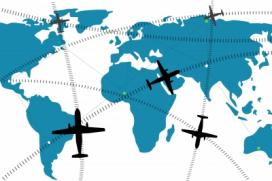
- Travel Advisories |
- Contact Us |
- MyTravelGov |
Find U.S. Embassies & Consulates
Travel.state.gov, congressional liaison, special issuance agency, u.s. passports, international travel, intercountry adoption, international parental child abduction, records and authentications, popular links, travel advisories, mytravelgov, stay connected, legal resources, legal information, info for u.s. law enforcement, replace or certify documents, before you go.
Learn About Your Destination
While Abroad
Emergencies
Share this page:
Crisis and Disaster Abroad: Be Ready
What the Department of State Can and Can't Do in a Crisis
Information for U.S. Citizens about a U.S. Government-Assisted Evacuation
Traveler's Checklist
Safety and Security Messaging
Best Practices for Traveler Safety
Staying Connected
Smart Traveler Enrollment Program (STEP)
Traveler Information
LGBTQI+ Travelers
Adventure Travel
High-Risk Area Travelers
Travelers with Dual Nationality
Journalist Travelers
Faith-Based Travelers
Pilgrimage Travelers (Hajj and Umrah)
U.S. Students Abroad
Cruise Ship Passengers
Women Travelers
Travelers with Disabilities
Older Travelers
U.S. Volunteers Abroad
Travelers with Pets
Travelers With Firearms
Travel Agents
Travel Safety - Race and Ethnicity
U.S. Travelers in Europe's Schengen Area
Your Health Abroad
Insurance Coverage Overseas
Driving and Road Safety Abroad
Customs and Import Restrictions
Information for U.S. Citizens in Russia – Travel Options Out of Russia
Lodging Safety
Paris 2024 Olympics and Paralympics
DHS Trusted Traveler Programs
Get Required Documents
Safeguard Your Documents! Make copies of all your travel documents. Leave one copy with a trusted friend or relative and carry the other separately from your original documents. Also take a photograph of your travel documents with your phone to have an electronic copy.
- Passport: Check your passport expiration dates as soon as you start planning a trip, and remember passports issued to children under 16 are only valid for only five years. Some countries – including most of Europe – will require that your passport expiration date is at least six months away. If you need a new passport, apply early to allow for delays; click here for passport information.
- Visas: Check with the embassy of your destination regarding visa requirements.
- Medications: Some prescription drugs (including narcotics) and some U.S. over-the-counter medications are illegal in other countries. Check with the embassy of your destination(s) about regulations and documentation before you travel.
- Consent for Travel with Minors: If you are traveling alone with children, foreign border officials may require custody documents or notarized written consent from the other parent. Check with the embassy of your foreign destination before traveling to see what you may need.
- International Driving Permit: Many countries do not recognize a U.S. driver's license, but most accept an International Driving Permit (IDP). You may also need supplemental auto insurance. Read more about driving and road safety abroad before you go.
Importance of Travel Insurance
- The U.S. government does not provide insurance for U.S. citizens overseas. We do not pay medical bills or unexpected costs. We highly recommend that you purchase travel insurance before you travel to cover emergency medical care, either as part of or separate from trip cancellation insurance.
- Health Insurance: Medical facilities and providers abroad may require cash up front and may not accept U.S. insurance plans. U.S. Medicare/Medicaid does not provide coverage outside the United States. Check your health care policy to see if it will cover you overseas. If not, consider buying supplemental insurance . Make sure the insurance you purchase covers any special medical needs or risks you anticipate on your trip.
- Emergency Medical Evacuation: Evacuation for medical treatment can cost more than $100,000. You should strongly consider purchasing medical evacuation insurance in case of emergency overseas.
Get Informed
- Smart Traveler Enrollment Program (STEP) : Enroll at step.state.gov to receive travel and security updates about your destination, and to help us reach you in an emergency.
- Safety and Security Information: Read the Travel Advisory and Alerts for the countries you will be visiting at travel.state.gov/destination .
- Crisis Planning: Read Crisis Abroad: Be Ready
- Health Precautions: Read Your Health Abroad and check out recommendations for vaccinations and other health considerations from the U.S. Centers for Disease Control (CDC) and World Health Organization (WHO) .
- Money Matters: Before going abroad, notify your bank and credit card companies of your travel, and check exchange rates. For information about using cash, debit/credit cards, and ATMs overseas, read the country information page for your destination .
- Follow us on TravelGov on Twitter , Facebook , or Instagram

Every traveler is unique. Learn more before you travel.
Other Information for U.S. Citizen Travelers
- Information for Travel Agents
- Travel to High-Risk Areas
- Traveling with firearms
- Traveling with a pet
- Travel during tropical storm season
- FBI Safety and Security Information for U.S. Students Traveling Abroad
- Customs and import restrictions
- Global Entry
- TSA Pre-check
Emergency Assistance
Sometimes, in spite of careful planning, things still go wrong during a trip abroad. Contact the nearest U.S. embassy or consulate overseas or our Washington, D. C. office ( 888-407-4747 or 202-501-4444 ).
The Department of State assumes no responsibility or liability for the professional ability or reputation of, or the quality of services provided by, the entities or individuals whose names appear on or are linked to the above page. Inclusion of private groups on this page is in no way an endorsement by the Department or the U.S. government. The order in which names appear has no significance. The Department is not in a position to vouch for the information.
Download the checklist
Download the Traveler's Checklist before you go!
Enroll in STEP

Subscribe to get up-to-date safety and security information and help us reach you in an emergency abroad.
Recommended Web Browsers: Microsoft Edge or Google Chrome.
Learn about your destination
Make two copies of all of your travel documents in case of emergency, and leave one with a trusted friend or relative.
External Link
You are about to leave travel.state.gov for an external website that is not maintained by the U.S. Department of State.
Links to external websites are provided as a convenience and should not be construed as an endorsement by the U.S. Department of State of the views or products contained therein. If you wish to remain on travel.state.gov, click the "cancel" message.
You are about to visit:
- Search Please fill out this field.
- Newsletters
- Trip Planning
TSA Requirements and Advisements for Air Travel
The Transportation Security Administration, or TSA , updates travel requirements and issues information for traveler’s awareness to keep everyone as safe as possible while traveling. Even though it can be a nuisance, we must follow the rules, which seem to change often.
TSA asks travel agents to make their customers aware of tips and requirements before they go.
- Give a printed or email notice concerning the liquid rules for carry-on bags, particularly for travelers flying infrequently.
- Ask customers when they flew last and update them on airport security procedures.
- Give travelers the web page, www.tsa.gov, for questions they may have.
- Inform travelers on the current acceptable forms of ID.
TSA now requires airlines to collect the exact name on ID, plus date of birth, and redress number if a traveler has been issued one. Travel agents and tour operators must collect this information when making airline reservations. Travelers may be denied boarding or delayed if the information on their reservations is not accurate.
Redress number
Secure Flight is the behind the scenes watch list issued by the TSA. For travelers frequently asked to go through extra scrutiny at the airport, or having screening issues, a redress number may be important. This advanced program will allow the traveler to set up an inquiry as to why this is happening. After applying, a redress number may be given to attach to an airline reservation, and hopefully eliminate the extra scrutiny.
Carry-on Luggage Guidelines
- Travelers are allowed 3.4 oz (100ml) bottles in a clear 1-quart zip-top bag per passenger. This enables the security officers to check and clear items quicker collected into one bag separated from the carry-on bag. Some bottled water and beverages can now be purchased after screening that can be brought aboard the plane.
- Medications, food, and baby formula are allowed in limited quantities. Check with the airline or TSA for specific questions. They need to be declared at the security checkpoint.
- Items such as box cutters, knives, and razor blades are not permitted in carry-on bags. Sporting goods such as baseball bats and golf clubs are not permitted, along with tools such as hammers. Scissors with blades less than 4 inches and disposable razor blades are permitted in carry-on bags.
- If in doubt, the items should not be put in the carry-on bag, but be sure it is suitable then to put in checked bags.
Checked bags
Checked bags will also be scanned, and can be opened and searched as well. Any sharp objects in checked luggage should be wrapped as not to harm baggage handlers that may inspect your checked luggage.
From time to time, the State Department issues alerts for US citizens traveling to destinations such as Europe. The State Department suggests registering travel arrangements with the Consulate Section of the U.S. Embassy, before traveling. The most recent security information can be obtained by calling 1-888-407-4747 from the U.S.A. and Canada.
When in doubt, check the TSA web pages, as rules for flying change often. Travel professionals have an increasing amount of responsibility for making sure their customers fly without interruption.
Related Articles
More related articles.

Not too Much, Not Too Little: My Carry-On Only Printable Packing List
This post may contain affiliate links. As an Amazon Associate I earn from qualifying purchases.

I wasn’t always good at packing. Trip after trip, I’d forget something — usually something small and easily replaced, but an inconvenience nonetheless. Finally, I learned my lesson, got organized, and wrote out a list. Ever since, I’ve been using the exact same printable packing list and haven’t had problems since. If you’re looking for a starting place of your own, I’m happy to share.
This packing list is minimalist on purpose. I nearly always pack carry-on only, mostly because I hate waiting for my suitcase at baggage claim and partially because I hate dragging too much from one hotel to the next. If you want to bring more than a carry-on, use this list as a starter and add to it as needed.
I originally shared this list in 2016 but it was in need of a refresh in 2021, not for the list of items but for brands and specific gear recommendations. Of course, if you have your own favorite products, pack what you have and only opt for new if you’re unhappy with what you have.
This version of my printable packing list was the basis for my most recent trips including Montenegro , Idaho, Guatemala , and the UAE. Even though those trips each had different activities, climates, and needs, the list is comprehensive and flexible enough to work anywhere.
This is a long post. If you’re in a hurry, scroll to the section you want tips on, bookmark this page for future use, or head directly to the printable packing list PDF at the end.
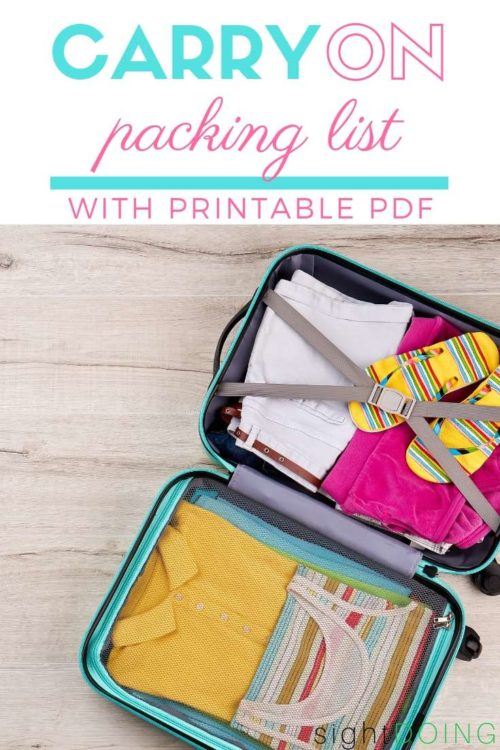
Focus on the Bottom Line First
I won’t bore you with an argument to travel carry-on only. You either love it or hate it…and that won’t change unless you want it to.
What I do think is important: being realistic about what you choose to bring. It boils down to two recommendations:
- Don’t over-prepare. This isn’t Boy Scouts. You only need to be pack for likely scenarios, not one-in-a-million chances.
- Pick a bag that you can carry. If you can’t pick it up or maneuver it through an airport, downsize and try again. In my opinion, one large bag is easier than two smaller ones.
Becky’s Tried and True Packing List and Gear Recommendations
You do not want to be the person who flies halfway around the world only to realize your travel gear is subpar. Not only is it frustrating, but you’ll waste valuable time looking for replacements while traveling instead of spending your time sightDOING. Skip all the inferior products and go straight to the good stuff.
Start with the Right Bag
I alternate between a rolling suitcase and a backpack for my primary bag, depending on the type of trip I’m taking. Either way, everything on the inside is neatly organized with packing cubes to keep things contained and make it easier to find what I need.
More often than not, I travel with an old Delsey carry-on roller suitcase. It’s a bit banged up, but still works fine and I haven’t found the right suitcase to replace it with yet.
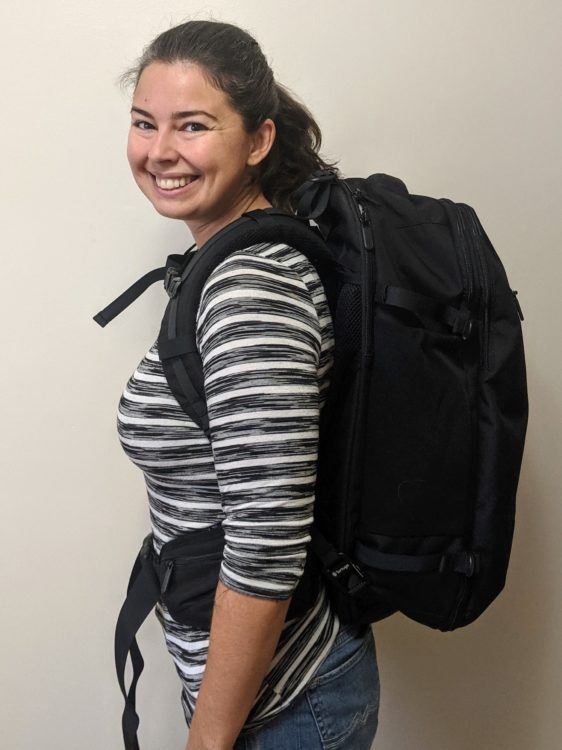
When I’m traveling to destinations where I expect to schlep my stuff around more, I take my Tortuga Backpack . It’s carry-on sized, holds everything I need, and fits comfortably without getting too heavy thanks to the built-in hip belt.
For a personal item that fits underneath the seat in front of me on an airplane, I typically use a laptop bag.
For a daily carry bag when I’m at my destination, I like foldable backpacks that pack down to very little space, like my waterproof Matador Daylite .
Packing the Essentials
There aren’t a lot of essentials, but you should be prepared with your passport, any visas or other required documentation to enter your intended destination (like a vaccination card ), and a few forms of payment.
I typically pack at least one Visa and one Mastercard with no foreign transaction fees, just in case one card type isn’t accepted somewhere, plus my Schwab ATM/debit card and enough cash to last me through the first 24 hours.
Pack the Right Clothing
Clothing makes up the bulk of what I bring and I’ll be honest, I still tend to overpack in this category. I often think I’ll want workout gear or something to go out at night and I usually don’t use either. Pack what you’ll actually wear and be honest about how you tend to travel. For longer trips, laundry on the road is relatively easy and costs less than what you’d spend to check a bag.
Realistically, you probably already have what you need in your closet and don’t need to shop for specialty gear. I avoid fussy fabrics on the road (who wants to iron on vacation?) and look for items that can be mixed and matched for different looks.
How much is too much? My goal is always to fit my clothes into 3 packing cubes : I use two medium-sized cubes for my main clothes and one small cube for socks and underwear. I don’t worry about the exact number of shirts and pants and instead focus on the amount of space it takes up altogether. If the cubes don’t zip, it’s time to take something out.
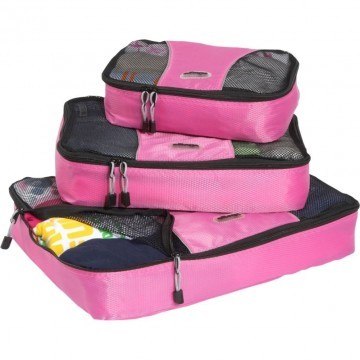
Keep shoes to the absolute essentials: they’re bulky and heavy. I do most of my hiking in trail runners instead of boots (they’re smaller, lighter, and work for 95% of the trails I’m on) and I pack a pair of good walking sandals as well for just bumming around town or the beach. On some trips, I throw a pair of flats in my bag too for dinners out.
Still want specific recommendations? Try Prana Halle pants , KÜHL Freeflex shorts , Aviator jeans , Bluffworks t-shirts , North Face fleece jackets , and Smartwool socks . For footwear, I swear by my Xero Shoes sandals but don’t care for their other shoe styles.
Don’t forget to grab a swimsuit, raincoat, or other outerwear as needed for your destination.
Packing Personal Care Items and Accessories
This section has a lot of items but they’re typically all small so don’t get overwhelmed.
For hygiene, you’ll want a toothbrush and toothpaste, ravor and shaving cream, deoderant, brush/comb and hair styling products, cosmetics and makeup remover, and maybe cotton swabs or other applicators. Shampoo, conditioner, soap, and lotion are at your discretion: I know some hotels are likely to provide them but when in doubt, I bring my own in GoToobs to prevent leaking.
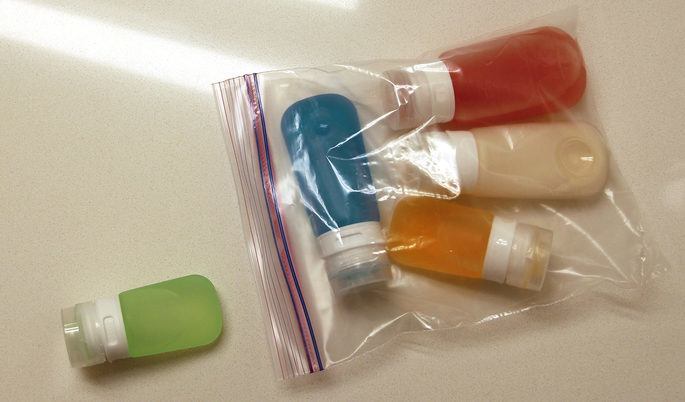
The specific brands you use will depend on your personal needs and preferences but some of my go-tos are a Billie razor (works well and has an awesome travel case), Wet brush , and Human + Kind family remedy cream . I also think everyone needs a Steripod to keep their toothbrush clean and protected.
You’ll also need a handful of accessories, which may include hair ties or clips, neck ties, jewelry, hats or gloves, belts, sunglasses, or anything else you normally reach for at home to complete your look. You may also want to consider a fake wedding ring instead of bringing valuables from home: there are tons of cheap lookalike options on Amazon .
If you tend to get sick while traveling (or are accident prone), you can assemble an entire travel first aid kit to bring with you. You know yourself best and what you tend to need when away from home, whether that’s anti-inflammatories, anti-diarrheals, motion sickness meds, electrolytes , or whatever.
99% of the time I only need ibuprofen and bandages but when I expect to be in remote locations away from local pharmacies, I use a weekly pill case to carry seven different types of over-the-counter meds (one in each “day” and labeled accordingly).
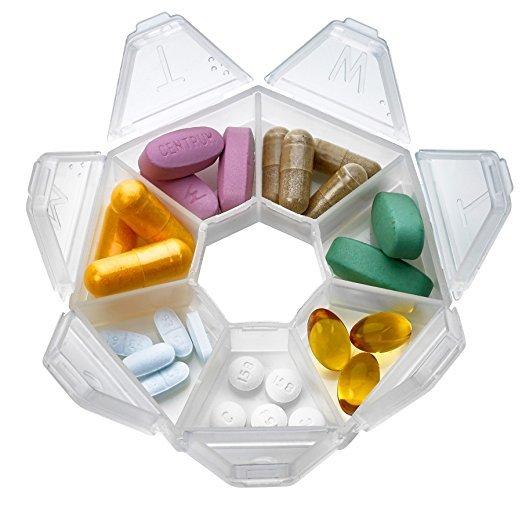
Make sure to also consider destination-specific health items, like DEET insect repellant ( wipes are easier to pack than sprays) or a water filter .
You’ll also want to bring any and all prescriptions you need. Don’t forget them!
In-Flight Needs
For long-haul flights , you’ll want to be comfortable.
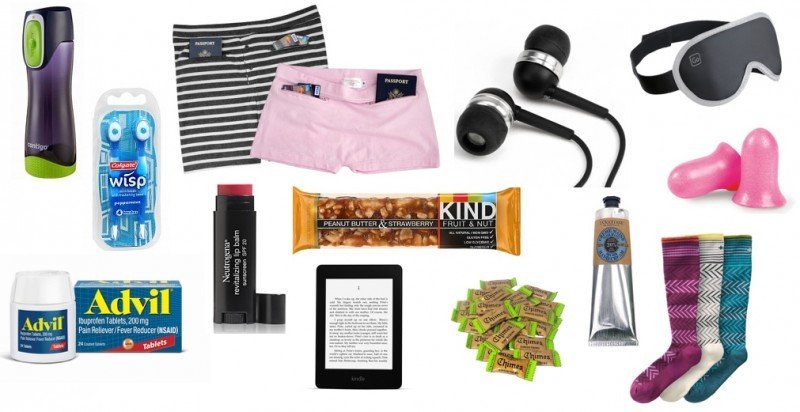
My top items are a water bottle and travel mug (yes, I bring both and fill them up at the airport). I also bring lip balm, an eye mask, earplugs, compression socks , ginger candy , and plenty of entertainment. For me, that’s usually podcasts pre-loaded on my phone and a Kindle with lots of good books.
Packing Electronics
Bringing electronics is a balancing act — we live in an era where technology is a must-have, but you also don’t want to overdo it with expensive gear that’s at risk of being broken or lost.
I always travel with my laptop since I work from the road but kudos to you if you can truly disconnect! I sometimes — but not always — bring a DSLR camera and other times rely on my phone for pictures. Headphones and an external battery round out my list.
I’m also in love with my new wall adapter : it’s super compact and yet can charge up to 4 devices simultaneously (two plugs, one USB-A, and one USB-C). That keeps me covered without having to pack a separate multi-plug…and it has attachments for different international outlet styles so you can head anywhere in the world.
Packing Everything Else
Here’s where I’d love you to chime in: what miscellaneous stuff do you bring?
I always have an old-fashioned paper notebook and pen. For the past year or so, I’ve also consistently packed my foldable yoga mat.
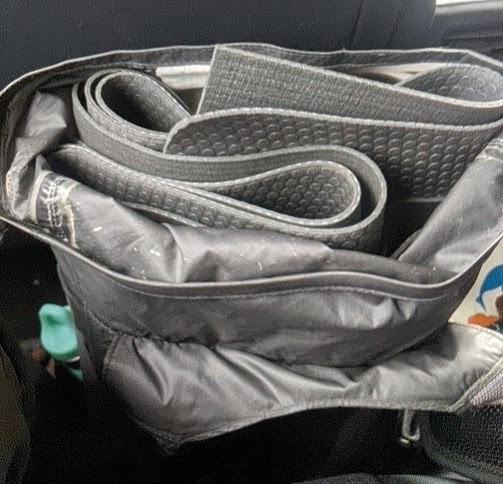
On wildlife-oriented trips, I also bring binoculars, and for trips where I expect early mornings, I bring tea bags along since it’s easy to find hot water even when coffee is unavailable.
At the end of the day, it’s a fully packed bag but I use it all.
What I’ve Stopped Packing
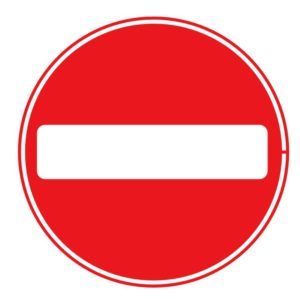
Packing lightly is just as much about what you don’t bring. A few things don’t make my cut:
Laundry Care: I used to wash clothes by hand using a Scrubba . Now, I either send it out (in low-cost countries) or settle for plain soap and a hotel sink. It might not be perfect, but it’s good enough.
Headlamp: Unless I know I have an adventure planned, I skip the headlamp and plan on using my cell phone for a flashlight in case of emergency.
Voltage Converters: Unlike adapters (which help you fit your plugs into the shape of other countries’ wall outlets), voltage converters are rarely necessary. Almost all modern electronics accept dual voltage, so there’s no need to bring a separate, heavy device that transforms voltage from 240V (frequently used worldwide) to 120V (typical in the USA).
Paper copies of travel documents: I pull up confirmation numbers, credit card backup information, and other documents from secure internet-based storage. It’s a good idea to share that info with someone you trust back at home, too.
Solid Toiletries: For awhile, I stuck to solid shampoos and other items in order to avoid TSA restrictions on liquids and gels. Most of the products don’t work well and/or are very expensive…and I always seemed to have extra room in my ziploc bag anyway. Now I stick to liquids.
Anything and everything I don’t use at home: Think twice before packing items you don’t ordinarily use at home. For me, it’s things like sewing kits and scarves. Some people love them, but they make no sense for me.
Printable Packing List
Get ready for your own trip with carry-on packing list or download the PDF for easy printing!
In an effort to be helpful, I’ve added a few popular packing items onto the checklist even if I don’t use them. Use your best judgment and don’t pack items you don’t think you’ll personally need.
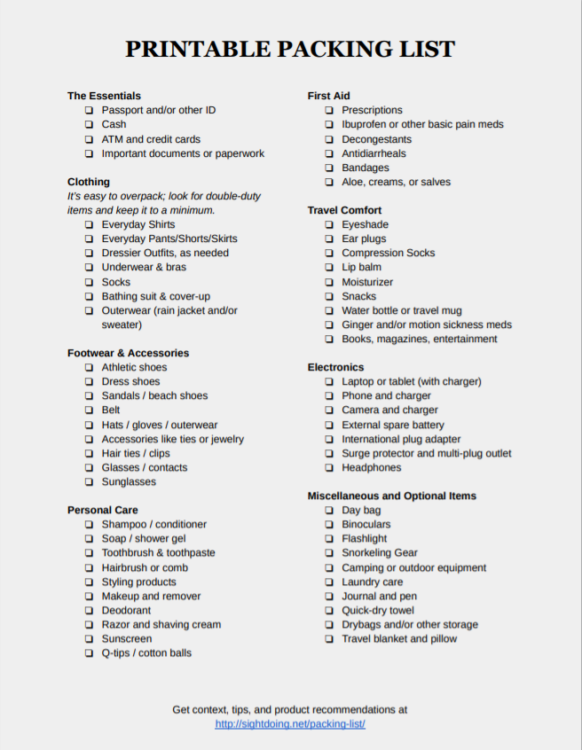
* * *
Packing is such a personal chore – what do you agree and disagree with?
21 thoughts on “not too much, not too little: my carry-on only printable packing list”.
I carry a mini-flashlight in my purse or day bag. It is amazing how many times I have used it! Handy on red eye flights to find your things without turning on the overhead light, and for reading maps. My last trip to Poland, I even used it in some museums and crypts to read inscriptions and notes. I keep it bedside at night for an emergency light too. For the most usefulness, get a bright LED flashlight.
@Sharon, I used to carry one also but now I use my phone’s built-in flashlight (and my external battery pack has one too!).
This is a really solid packing list. I have recently started doing the same and have been refining ever since.
One thing to add from my persona list is a few sections for various scenario to remind myself for incremental items.
For example under a section for “If driving:”, i have items like glasses (which i need to drive with at night), international drivers license, phone holder (when i use my iPhone for GPS) etc
I have a couple other sections for “International trip” and “for camping”…
You have a great blog btw! Love the layout/organization.
@Jimmy, Good idea to still list out items that you only need sometimes. I’ve forgotten my car charger for phone (which I use as GPS) before!
I’m a tea-toting person too! There’s something about a familiar flavor that brings me comfort. Also, I love brown rice green tea and that can be very difficult to find when on the road. Cheers!
@Crystal, I’ve never heard of brown rice green tea but now I’m going to try and hunt it down!
I support that 100%. If you have trouble finding some, just let me know. It’s also known by its Japanese name “genmaicha”.
Its good to read about another person’s ideas about what to bring or not bring. I’ve enjoyed your post, and might have to implement some of your ideas in my travels. Thanks!
@Shawn, Anything different you recommend?
This is genius! I try to ONLY pack carry on whenever possible. It’s amazing what you realize you don’t really need.
I have never been able to pull a carry-on only trip off!! These are great tips for packing, it can be overwhelming to make sure you don’t forget anything.
@Jenny, More often, my problem these days is OVER packing with stuff I don’t need!
I love the printable packing list! We will be traveling a bit this summer, so I think this is super important! I always have a difficult time trying to figure out the best things to pack. Thanks for sharing these tips!
What a great list. I think you pretty much covered everything. I always struggle with the right shoes but I’ve learned to wear my heaviest pair. I’m a dansko gal but also have the trail running shoes you mentioned. Dansko’s because of the weight get worn not packed.
I’m 72 years old and don’t do any heavy-duty hiking/activities. However, I am soon going on a 12-day South African Safari with G Adventures (National Geographic Journeys) and will be participating in their basic “game drives” and other primary activities.
Can you recommend a lightweight hiking/walking shoe (or boot) that would be appropriate for this trip?
Thanks in advance for all your great information!
@Budd, I like “trail runner” type shoes because they have pretty good traction on the bottom but are lightweight and airy enough to stay cool in warm climates. All sneaker brands will sell them (Nike, Reebok, etc), if you have a favorite. Hard to give exact styles since everyone’s foot shape and size is different. To go up a level in hiking quality, look for Merrell or Keen.
Great tips for packing. I have always had a problem in figuring out waht to carry and what not to carry. Really helpful read, thanks.
@David, My pleasure to help!
Great ideas. I have been doing carry-on only for the last 10 yrs and we usually travel in the fall. For me, depending on the length of the trip, 3 pr. of pants (1 black semi-dress, navy blue, grey or brown), blouses/shirts, half a many as the days of the trip. Example, if the trip is 14 days then I take 7 blouses/shirts and a mix of short and long sleeves. I only take 3 pr .of underwear and wash them out at the end of the day and 2 bras. 1 sleeping outfit, 1sweater, 1 lightweight rain coat that is packable, 1 packable down coat. 2 pr of shoes, one ballet slipper for evenings and 1 pr of Vionic sandal (which I wear on the plane, because it is easier to get through TSA and a 2 of large scarves, one black and one white. On the plane outfit is jeans, tank top, white long sleeve blouse, black wool jacket, scarf. On of the most important items is a contact eye case, 1 side Vaseline/the other side Vick. Kindle, head phones, cell phone and copy of important documents sent to my email address and same in a folder on that acct. Credit cards, 2 different companies and a debt card. For women a small crossbody bag worn in front on your body. This is the only way to travel. Happy traveling everyone.
Back in the early 1980s when I first started traveling, Rick Steves’ 2nd edition book “Europe through the back door” recommended “Take less stuff and more money”. I’ve been doing that (mostly) ever since.
Always hated packing, I never know what to take with myself! Also I think you should slways leave a space in a bag , as you always end up buing a lot of things while travelling!
Leave a Comment Cancel Reply
Your email address will not be published. Required fields are marked *
- Theaters >
- Asia-Pacific
- - Storm Tracker
- Middle East
- Veterans >
- Map of Memorials
- Living >
- Entertainment
- - Video Games
- Europe Travel
- - Quick Trips
- - After Hours
- Pacific Travel
- The Meat and Potatoes of Life
- U.S. Travel
- Opinion >
- Storm Tracker >
- Promotions >
- Promotion Rules
- Get Stripes >
- Stripes Lite
- Archives/Library
- Special Publications
- Mobile Apps
- Email Newsletters
- Digital Access
- Home Delivery
- Branches >
- Marine Corps
- Coast Guard
- Space Force
- History >
- Archive photo of the day
- Sports >
- Perspectives
- Multimedia >
- - Military Matters
- - Force for Hire
- Communities >
- Stripes Europe
- Stripes Guam
- Stripes Japan
- Stripes Korea
- Stripes Okinawa
- Our Other Websites >
- In Memoriam
- Month of the Military Child
- Best of Germany
- Best of the Pacific
- Letters to Santa
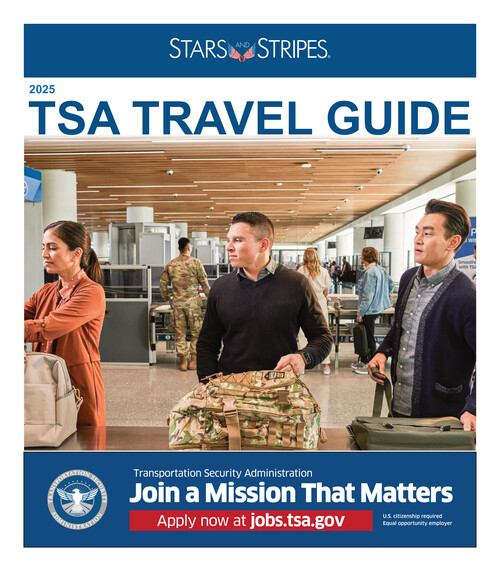
Stars and Stripes is proud to partner with the Transportation Security Administration (TSA) and announce the first edition of the TSA Travel Guide.
This guide provides a deeper understanding of TSA and the people who make up the agency. Inside, you will find tips to make traveling, alone or with family, easier and less stressful. TSA works to keep travelers safe across the entire transportation system, and this guide is filled with stories of talented employees, many of whom are veterans.
TSA operates under the U.S. Department of Homeland Security and provides guidance on security screening, TSA PreCheck, travel tips, and more. Visit www.tsa.gov for additional information.
For information about advertising, please contact us .
- Combined Federal Campaign
- Education Guide
- Education and Transition Guides
- Europe Grad Tab
- Pacific Grad Tab
- Financial Planning Guide
- Insurance Guide
- Health and Fitness Guide
- Aviano Medical Guide
- Germany Medical Guide
- Vicenza Medical Guide
- Naples Medical Guide
- Christmas Markets
- Europe Community Site
- Tattoo Armed Forces
- Welcome to Bahrain
- Welcome to Germany
- Welcome to Northern Italy
- Welcome to Naples
- Welcome to Poland
- Welcome to Sigonella
- Welcome to Spain
- Welcome to Türkiye
- Welcome to the UK
- - Wiesbaden
- - Kaiserslautern
- - Stuttgart
- Destination Paradise
- Healthy Living – Korea
- Healthy Living – Guam
- Healthy Living – Okinawa
- Welcome to the Pacific
- Guam Community Site
- Japan Community Site
- Korea Community Site
- Okinawa Community Site
- Military Spouse Entrepreneur Guide
- 9⁄11 Ten Years Later
- 100 Years of Military Aviation
- 150 Years on Hallowed Ground
- Baseball in the Military
- Employer Support of the Guard and Reserve
- Invictus Games
- Operation Tomodachi
- Perfect Mess Cookbook
- Remembering the Fallen
- Wheels Down
- Women Air Force Service Pilots
- Veterans Benefits Guide
- Veterans Tribute Guide
- Stars and Stripes Anniversary Editions
- Transition Guide
- Welcome to the National Capital Region
- Communities

10 Tips to Save You Time in the TSA Line
As air travel surges nationwide, blue sky news has advice to help you pass through security faster.
By gmastrangelo
Published August 12, 2024
Read Time: 3 mins
Pittsburgh International Airport is undergoing its busiest time in almost a decade.
Naturally, more flights and busier travel periods mean longer TSA lines.
More than 970,000 passengers traveled through PIT in June – the highest passenger total in a single month since July 2005. Next year, PIT will have a brand-new terminal with a more efficient security experience.
RELATED: Red Hot Summer: PIT Reports Busiest Month in 19 Years
Since these numbers started climbing earlier this year, TSA has encouraged passengers to arrive even earlier than the typical two hours before flights, at least for morning flights. But that’s not the only way to ensure you speed through security lanes and make it to your gate with plenty of time to spare before takeoff.
Until then, use these tips to make your next journey through the airport a lot quicker.
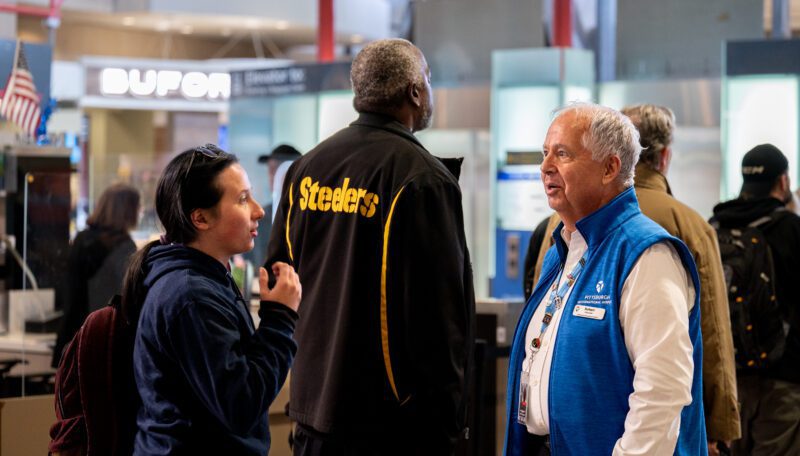
PIT’s airport ambassadors and customer care agents can be found throughout the terminals to answer questions and assist travelers with their needs. (Photo by Beth Hollerich)
No. 1. Sign up for TSA PreCheck.
Travelers with PreCheck do not have to remove their shoes, belts and electronic equipment from bags – saving time in the security line. With this option, passengers typically move more quickly than standard security lines. With multiple options, signing up is easier than ever.
No. 2. Reserve your parking online in advance.
PIT allows all passengers to reserve parking spots online, guaranteeing a spot in a preferred lot. By reserving your parking in advance, you can spend less time worrying if your preferred lot is full, giving you a stress-free, convenient start to your airport experience.
No. 3. Check in online with your airline before you arrive at PIT.
Most airlines allow you to check in for your flight at least 24 hours before your scheduled departure time. This helps you avoid the lines on the ticketing level. Your airline’s app or website is also a helpful resource for getting updates on any potential changes to your departure time.
No. 4. Check with your airline to learn when its ticketing counter opens.
For early morning flights, reach out to your airline to find information on what time ticket counters open so you can plan your airport arrival time accordingly.
No. 5. Sign up for CLEAR.
CLEAR allows passengers to move up to the TSA security checkpoint in a priority lane, and travelers using CLEAR do not have to produce an ID at the checkpoint. CLEAR now provides the opportunity for passengers to sign up for TSA PreCheck at the checkpoint. With both CLEAR and TSA PreCheck, passengers have the quickest route through the security checkpoint.
No. 6. Leave extra time if you need to check a bag.
If you know you need to check a bag when you travel, give yourself additional time to do so at the ticketing level. Or if you are able, consider a carry-on to save time.
No. 7. Don’t be afraid to ask for help.
PIT’s Information Desk is staffed with customer care agents who are available to answer all your questions. Also be sure to look out for the friendly ambassadors in the blue vests roaming the terminals or at the Ambassador Desk on the Baggage Claim level. Like PIT’s customer care agents, their roles are to ensure all passengers have a safe experience from start to finish.
No. 8. Review the TSA rules before you arrive at PIT.
Make sure you know what items are prohibited at the TSA security checkpoint . By planning ahead and packing accordingly, the security screening process moves faster for you and everyone in line behind you.
No. 9. Book a mid-day flight if your schedule allows.
Early morning travel, especially from 4 – 7 a.m., is historically the busiest time to travel at PIT. If your schedule allows, consider booking a mid-day flight to avoid the early morning crowds.
No. 10. Familiarize yourself with airport signage.
To help you avoid any confusion in the security lines, look around for any signage directing the lines or ask an airport team member or volunteer to help you understand each sign. For example, signs direct TSA PreCheck travelers to PIT’s alternate checkpoint between 4 a.m. and 7 a.m. Monday through Friday.
Watch This Next
Watch: final steel beam set for new terminal.

Read This Next
Ceo viewpoint: acaa progress is thanks to our team.
Airport Authority success recognized

Stay Connected
Subscribe today.
Subscribe to get the latest news and updates on Pittsburgh International Airport, ACAA, breaking news, and innovative content on all things aviation!
Quick Links
Useful links.

As a news service of the Pittsburgh International and Allegheny County airports, our focus is to be the trusted source of airport and aviation news, trends and ideas – not just in the Pittsburgh region, but around the world. Blue Sky News is the place where we share stories of how our airports, employees and partners are advancing the region’s role as a world leader.

© 2023 – Allegheny County Airport Authority | Privacy Policy
PIT Initiatives
Recognition
Connect With Us
Subscribe to our email newsletter to receive the latest updates and breaking news!

#BlueSky AndYou
Sign up for our newsletter to stay up-to-date on the latest in aviation and beyond.
Can I Bring It on an Airplane? TSA Rules for Carry-ons, Checked Bags and the TSA Prohibited List [Updated for 2023]
Tsa approved dog carrier, guide to south cabo san lucas, top things to do in singapore, can you take a stroller on a plane, most unique hotels in san diego, the best travel strollers 2023, the ultimate list of tsa questions and answers, tsa precheck vs global entry: which one is better for you, where did americans fly to the most 2021, can i bring my medicine without the bottle on the plane.

An official website of the United States government
Here’s how you know
Official websites use .gov A .gov website belongs to an official government organization in the United States.
Secure .gov websites use HTTPS A lock ( Lock A locked padlock ) or https:// means you’ve safely connected to the .gov website. Share sensitive information only on official, secure websites.
Travel Tips: 3-1-1 liquids rule
You are allowed to bring a quart-sized bag of liquids, aerosols, gels, creams and pastes through the checkpoint. These are limited to 3.4 ounces (100 milliliters) or less per item. This is also known as the 3-1-1 liquids rule.


IMAGES
VIDEO
COMMENTS
Remove the 3-1-1 liquids bag and place it in the bin. Ensure pockets are empty (keys, tissues, currency, wallets, cell phones, etc.) and remove bulky jewelry (valuable items can be placed in carry-on). Remove your shoes and place them directly on the X-ray belt. Remove personal electronic devices larger than a cell phone from your carry-on bag ...
Travel Checklist Before Packing Liquids, gels and aerosols packed incarry -on must follow the3- 1-1 liquids rule : • 3.4 ounces or less per container • 1 quart size, clear, plastic, zip top bag (all liquids must fit in bag) • 1 bag per passenger . Review the prohibited items list for both carry-on and checked baggage.
TSA's Top Travel Tips. TSA partnered with Stars and Stripes News for special military guide. The special guide for service members and their families includes travel tips, such as how to prepare, pack and declare a firearm, checkpoint dos and don'ts, and an inside look at some of TSA's programs and employees, with a special military emphasis.
TSA will accept expired driver's licenses or state-issued ID a year after expiration. DHS has extended the REAL ID enforcement deadline to October 1, 2021. You can pull up your boarding pass with your phone using a mobile app for the airline you are flying on but you can also hold a printed boarding pass.
TSA TRAVEL TIPS FOR FLYING Here is a list of tips from the Transportation Security Administration for groups that are flying to their destination. The resource for this document is the TSA Website. Security Screening TSA has evolved from a one-size-fits-all security screening approach to a risk-based, intelligence-driven
Twitter. @AskTSA. Liquids, aerosols, gels, creams and pastes, in limited quantities, are safe to bring in carry-on baggage and must comply with the following rules: 3.4 ounces or less for liquids, gels, aerosols, creams and pastes. 1 quart-sized, clear, plastic, zip-top bag to hold the liquids. 1 bag per passenger placed in screening bin.
TSA's Travel Tips. TSA's Travel T. psBefore you go...Visit www.tsa.gov for all the latest. security policies.Liquids, gels, and aerosols are permitted in 3 ounce containers, placed in a 1 quart-size, clear plastic, zip-top bag, o. bag per traveler.Medically necessary liquids like breast milk, baby formula, and insulin, are permitted and ...
20 Travel with ease using TSA's disability notification card. Navigating airport security with a disability doesn't have to be a challenge. TSA offers a Disability Notification Card that you can present to the TSA officer, ensuring an effortless and respectful screening process. This card helps communicate your needs without unnecessary ...
TSA Contact Center. The TSA Contact Center is available to answer questions about traveling through TSA security, including checkpoint or checked baggage screening. Weekdays: 8 a.m. - 11 p.m. ET Weekends/Holidays: 9 a.m. - 8 p.m. ET Email: [email protected] Phone: 1-866-289-9673.
Learn What I Can Bring on the Plane. Learn what you can bring on the plane by reviewing the Transportation Security Administration's (TSA) list of what you can bring on the plane, what you cannot bring on the plane, and TSA's Liquids 3-1-1 rule. Please note that the final decision rests with the TSA officer on whether an item is allowed through ...
TSA's . Travel Checklist. Before Packing Liquids, gels and aerosols as carry-ons follow 3-1-1 guidelines: - 3.4 ounces or less per container - 1. quart size, clear, plastic, zip top bag (all liquids must fit in bag) - 1 bag per passenger Visit tsa.gov or download the MyTSA app to review the prohibited items list for both carry-on and checked ...
TSA has a "3-1-1" rule for liquids, aerosols and gels in carry-on baggage. Those substances must be in containers that are no more than 3.4 oz. in volume (100 ml), with all such containers in one clear quart -size plastic bag, and one such bag per passenger. For details see TSA's Traveler Information site.
Make copies of all your travel documents. Leave one copy with a trusted friend or relative and carry the other separately from your original documents. Also take a photograph of your travel documents with your phone to have an electronic copy. Check your passport expiration dates as soon as you start planning a trip, and remember passports ...
Travelers are allowed 3.4 oz (100ml) bottles in a clear 1-quart zip-top bag per passenger. This enables the security officers to check and clear items quicker collected into one bag separated from the carry-on bag. Some bottled water and beverages can now be purchased after screening that can be brought aboard the plane.
Printable Packing List. Get ready for your own trip with carry-on packing list or download the PDF for easy printing! In an effort to be helpful, I've added a few popular packing items onto the checklist even if I don't use them. Use your best judgment and don't pack items you don't think you'll personally need.
TSA works to keep travelers safe across the entire transportation system, and this guide is filled with stories of talented employees, many of whom are veterans. TSA operates under the U.S. Department of Homeland Security and provides guidance on security screening, TSA PreCheck, travel tips, and more. Visit www.tsa.gov for additional information.
Alcoholic beverages with more than 24% but not more than 70% alcohol are limited in checked bags to 5 liters (1.3 gallons) per passenger and must be in unopened retail packaging. Alcoholic beverages with 24% alcohol or less are not subject to limitations in checked bags. Mini bottles of alcohol in carry-on must be able to comfortably fit into a ...
Passengers can also reach out to the TSA Contact Center (TCC) with questions about TSA procedures, upcoming travel or to provide feedback or voice concerns. Travelers or families of passengers with disabilities and medical conditions may call the TSA Cares helpline toll free 855-787-2227, 72 hours prior to traveling with any questions about
With both CLEAR and TSA PreCheck, passengers have the quickest route through the security checkpoint. No. 6. Leave extra time if you need to check a bag. If you know you need to check a bag when you travel, give yourself additional time to do so at the ticketing level. Or if you are able, consider a carry-on to save time. No. 7.
Security Screening. TSA incorporates unpredictable security measures, both seen and unseen, to accomplish our transportation security mission. Security measures begin long before you arrive at the airport. TSA works closely with the intelligence and law enforcement communities to share information. Additional security measures are in place from ...
This leaves some discretion to the individual TSA officer. In the event you do experience any problems or encounter an uninformed TSA agent, we recommend calling TSA directly. Their phone number is 1-866-289-9673. FYI, here is a short video with some additional tips for traveling with infant care items.
TSA Travel Tips. Can I Bring It on an Airplane? TSA Rules for Carry-ons, Checked Bags and the TSA Prohibited List [Updated for 2023] January 5, 2023.
Travel. TSA PreCheck® expedited screening allows eligible travelers to keep on their shoes, light outerwear, belts and more. Learn more. Be prepared for your next flight. Learn about the checkpoint security screening process and policies. TSA Cares is a resource that provides travelers with disabilities and medical conditions.
You are allowed to bring a quart-sized bag of liquids, aerosols, gels, creams and pastes through the checkpoint. These are limited to 3.4 ounces (100 milliliters) or less per item. This is also known as the 3-1-1 liquids rule.